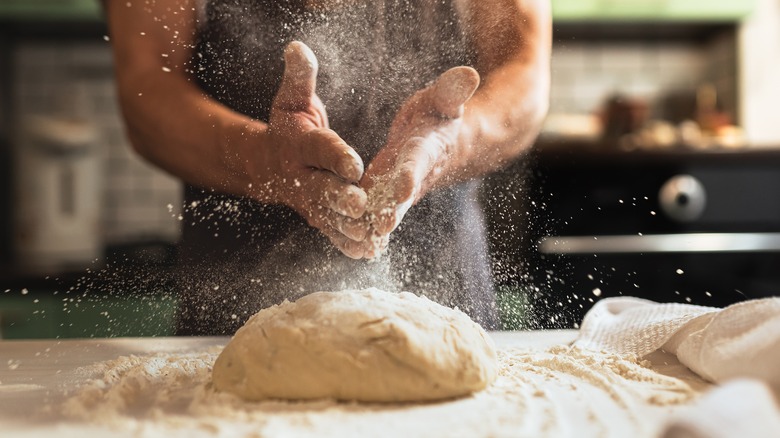A Warning From The CDC Tells Bakers To Avoid Eating Raw Flour After Salmonella Outbreak
You should absolutely think twice about playfully dipping into your next batch of cookie dough for a sneaky taste before popping them in the oven, as the CDC has reported a new string of Salmonella illnesses as of March 30. According to the report, 12 cases of food poisoning due to Salmonella have been recorded, with contaminated flour looking like the common denominator between all the cases. Although people may more commonly understand Salmonella poisoning as related to ingesting raw meat or eggs, flour is technically a raw ingredient, and it can be the ideal breeding ground for harmful bacteria. Typically, folks can avoid this illness as the germs are killed off during the hot baking process, however, when raw dough is eaten, that bacteria may just start wreaking havoc on your insides.
The outbreak has been linked to several states including California, Oregon, Nebraska, Minnesota, Iowa, Missouri, Ohio, Tennessee, Virginia, New York, and Illinois. Of the 12 illnesses reported there have been no deaths, however, 3 people have been hospitalized. Although the exact brand of flour has not yet been identified, the CDC recommends not ingesting any flour in its raw state, which means no bites of dough or batter. Let's take a look at some other ways that you can avoid food poisoning and the symptoms associated with this tummy-twisting illness.
What are some signs of Salmonella and how you can avoid getting ill
With news of the recent outbreak of Salmonella in raw flour, the CDC has issued a warning against ingesting and/or playing with raw flour or dough. This type of food poisoning can include symptoms like headache, fever, appetite loss, nausea, vomiting, stomach cramps, and diarrhea, according to Healthline. These symptoms can last anywhere from a few hours to up to 2 months depending on the severity of the illness. Although mild cases of food poisoning can be dealt with at home with rest and plenty of fluids, severe cases that result in diarrhea that lasts over a few days, significant dehydration, or a high fever of over 102 F should be treated at a hospital.
To help prevent yourself or anyone in your household from falling ill from Salmonella contamination, you can take a few easy precautions. For example, the CDC suggests using a meat thermometer to make certain that all of your meat, eggs, and flour are cooked thoroughly at the proper temperature. Also, wash your preparation area with great care — including any utensils — so that they are free of germs and bacteria. Also, make sure to store food safely in the fridge when you're done cooking, and if you're marinating or thawing out food, do it in the fridge instead of at room temperature.

